Business Law Case Study: Cafe Partnership, IP, and Customer Rights
VerifiedAdded on 2022/08/14
|6
|1471
|15
Case Study
AI Summary
This case study analyzes the legal considerations for a cafe business, addressing key issues such as whether to form a partnership, how to protect intellectual property like the cafe logo and an ice cream machine, and customers' rights under the Sale of Goods Act. It examines potential liabilities for food poisoning and negligence, providing insights on how the cafe owner can mitigate these risks. The analysis references relevant legislation like the Trademark Act, Patent Act, Unfair Contract Terms Act, and the Sale of Goods Act, along with case precedents such as Beale v Taylor, Barnett v Chelsea & Kensington Hospital Management Committee, and Spandeck Engineering (S) Pte Ltd v Defence Science & Technology Agency. The study offers a comprehensive overview of legal responsibilities and protections for cafe owners, emphasizing the importance of ensuring food quality, customer safety, and safeguarding intellectual property to avoid potential legal disputes.
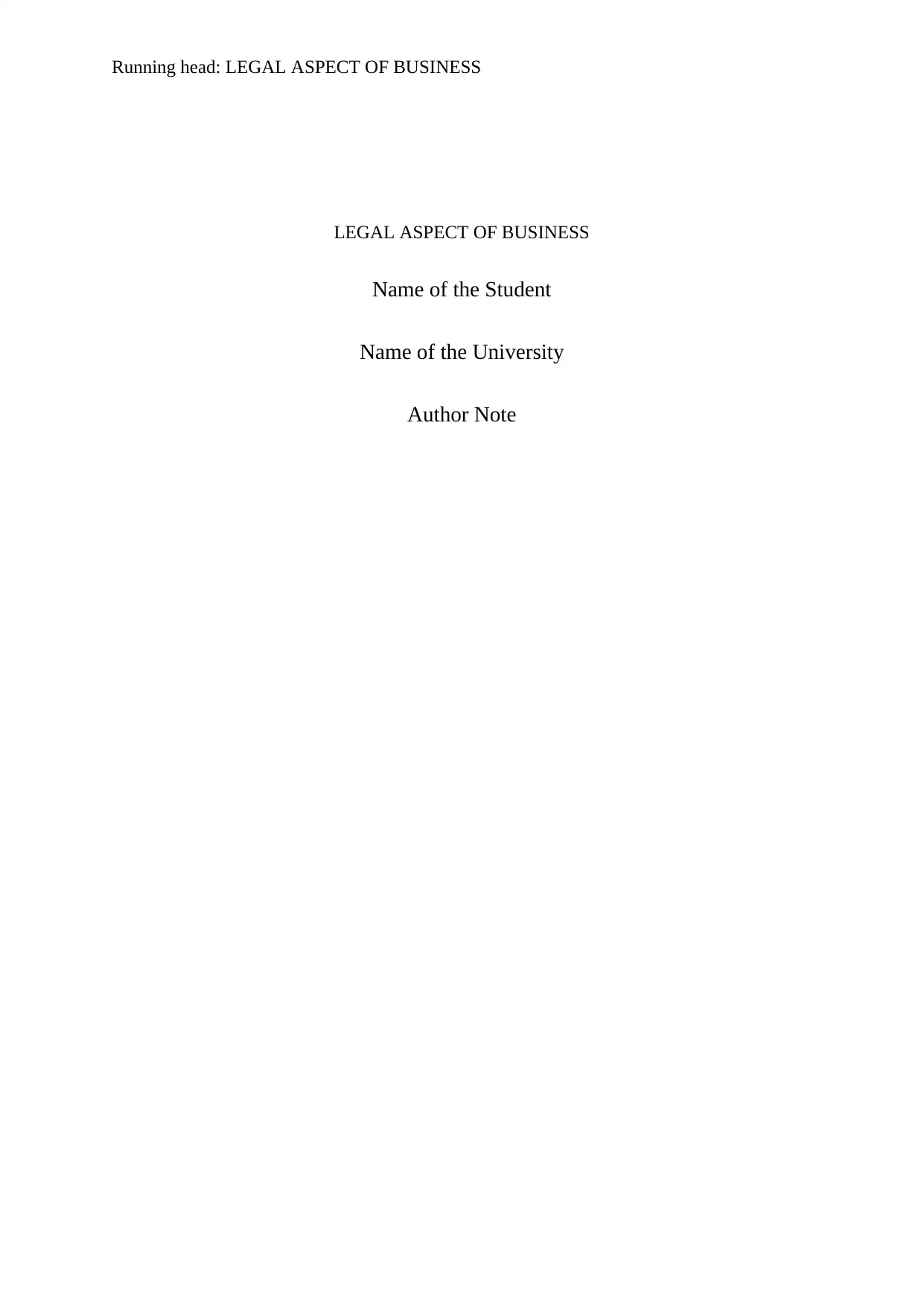
Running head: LEGAL ASPECT OF BUSINESS
LEGAL ASPECT OF BUSINESS
Name of the Student
Name of the University
Author Note
LEGAL ASPECT OF BUSINESS
Name of the Student
Name of the University
Author Note
Paraphrase This Document
Need a fresh take? Get an instant paraphrase of this document with our AI Paraphraser
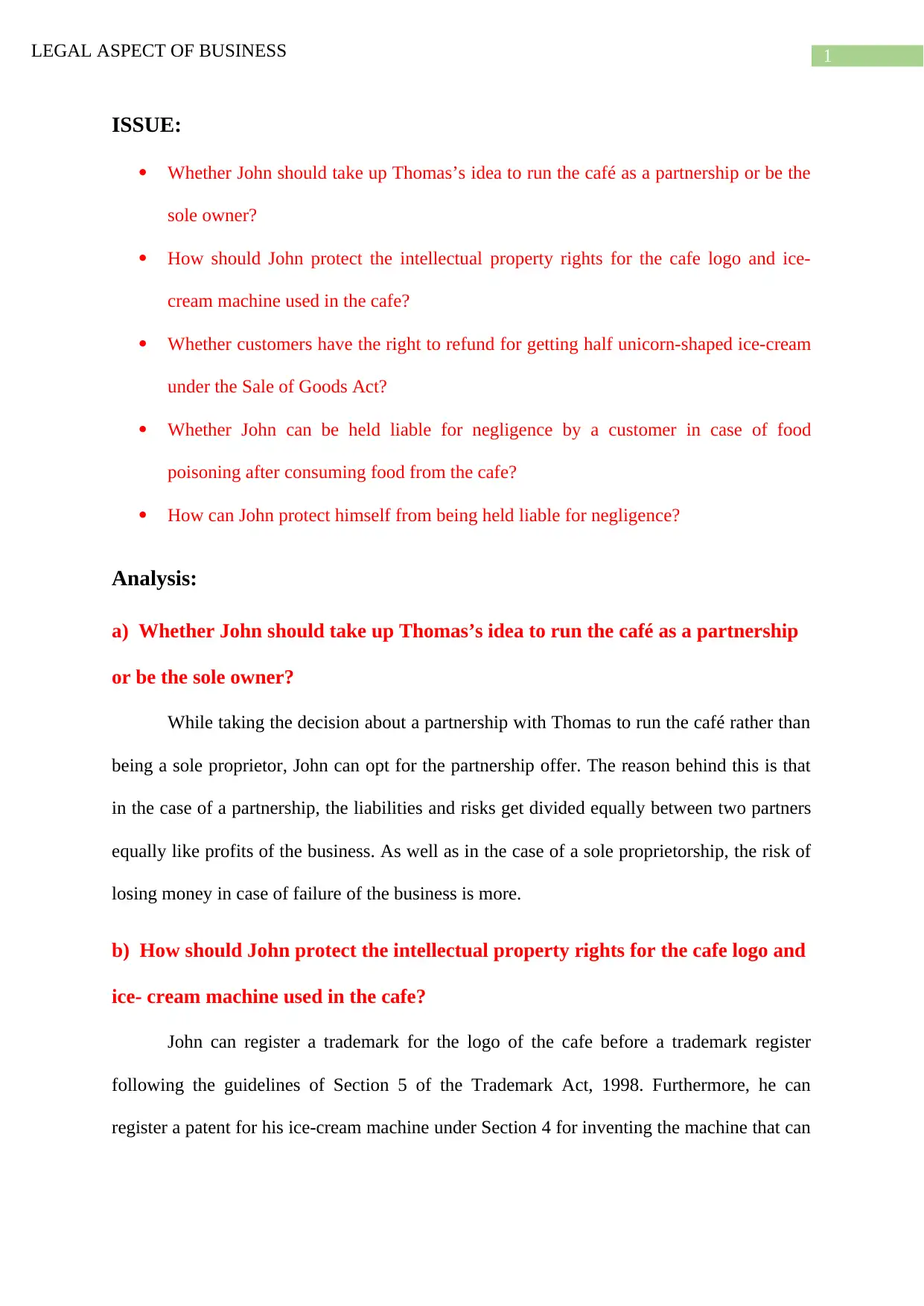
1LEGAL ASPECT OF BUSINESS
ISSUE:
Whether John should take up Thomas’s idea to run the café as a partnership or be the
sole owner?
How should John protect the intellectual property rights for the cafe logo and ice-
cream machine used in the cafe?
Whether customers have the right to refund for getting half unicorn-shaped ice-cream
under the Sale of Goods Act?
Whether John can be held liable for negligence by a customer in case of food
poisoning after consuming food from the cafe?
How can John protect himself from being held liable for negligence?
Analysis:
a) Whether John should take up Thomas’s idea to run the café as a partnership
or be the sole owner?
While taking the decision about a partnership with Thomas to run the café rather than
being a sole proprietor, John can opt for the partnership offer. The reason behind this is that
in the case of a partnership, the liabilities and risks get divided equally between two partners
equally like profits of the business. As well as in the case of a sole proprietorship, the risk of
losing money in case of failure of the business is more.
b) How should John protect the intellectual property rights for the cafe logo and
ice- cream machine used in the cafe?
John can register a trademark for the logo of the cafe before a trademark register
following the guidelines of Section 5 of the Trademark Act, 1998. Furthermore, he can
register a patent for his ice-cream machine under Section 4 for inventing the machine that can
ISSUE:
Whether John should take up Thomas’s idea to run the café as a partnership or be the
sole owner?
How should John protect the intellectual property rights for the cafe logo and ice-
cream machine used in the cafe?
Whether customers have the right to refund for getting half unicorn-shaped ice-cream
under the Sale of Goods Act?
Whether John can be held liable for negligence by a customer in case of food
poisoning after consuming food from the cafe?
How can John protect himself from being held liable for negligence?
Analysis:
a) Whether John should take up Thomas’s idea to run the café as a partnership
or be the sole owner?
While taking the decision about a partnership with Thomas to run the café rather than
being a sole proprietor, John can opt for the partnership offer. The reason behind this is that
in the case of a partnership, the liabilities and risks get divided equally between two partners
equally like profits of the business. As well as in the case of a sole proprietorship, the risk of
losing money in case of failure of the business is more.
b) How should John protect the intellectual property rights for the cafe logo and
ice- cream machine used in the cafe?
John can register a trademark for the logo of the cafe before a trademark register
following the guidelines of Section 5 of the Trademark Act, 1998. Furthermore, he can
register a patent for his ice-cream machine under Section 4 for inventing the machine that can
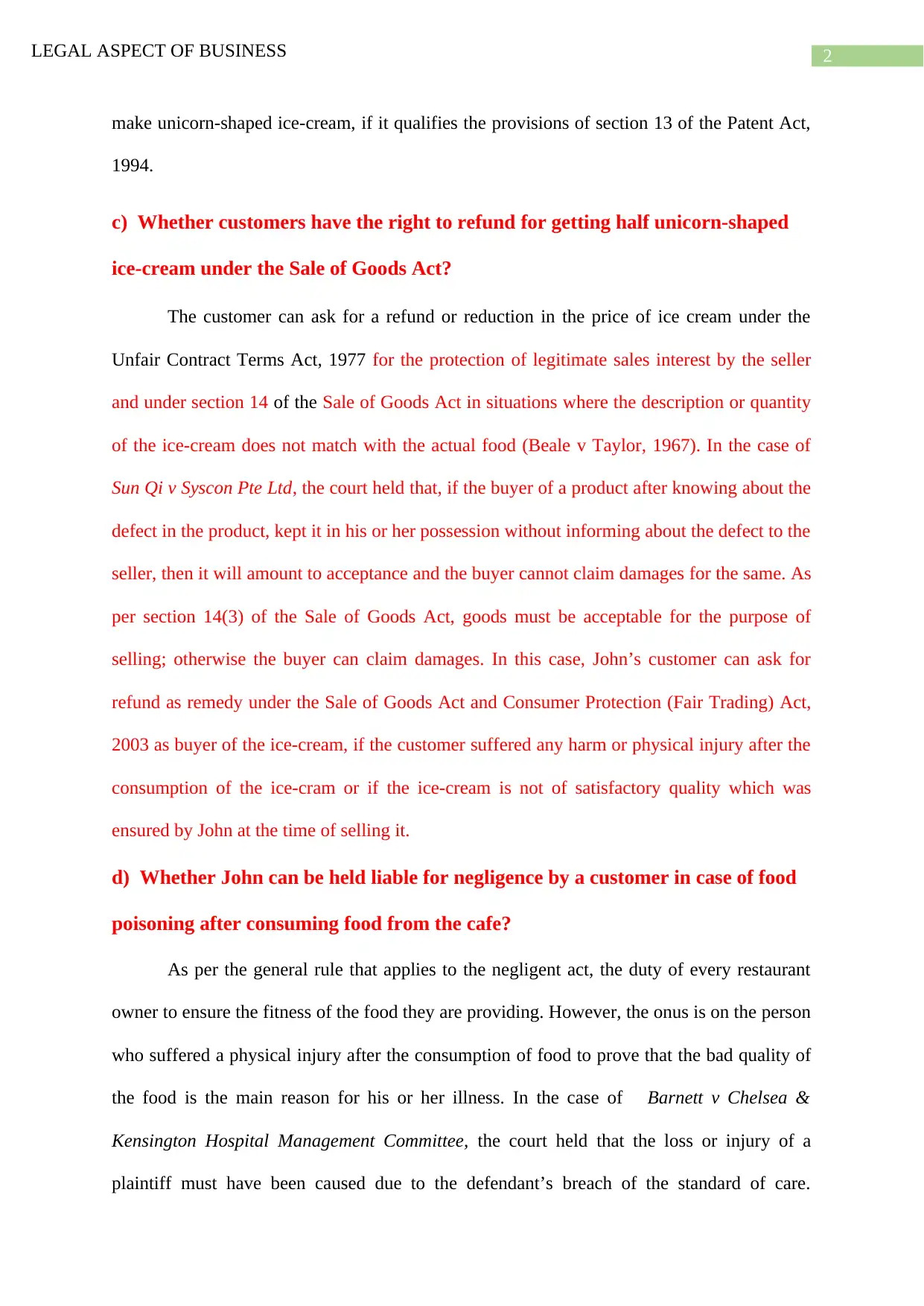
2LEGAL ASPECT OF BUSINESS
make unicorn-shaped ice-cream, if it qualifies the provisions of section 13 of the Patent Act,
1994.
c) Whether customers have the right to refund for getting half unicorn-shaped
ice-cream under the Sale of Goods Act?
The customer can ask for a refund or reduction in the price of ice cream under the
Unfair Contract Terms Act, 1977 for the protection of legitimate sales interest by the seller
and under section 14 of the Sale of Goods Act in situations where the description or quantity
of the ice-cream does not match with the actual food (Beale v Taylor, 1967). In the case of
Sun Qi v Syscon Pte Ltd, the court held that, if the buyer of a product after knowing about the
defect in the product, kept it in his or her possession without informing about the defect to the
seller, then it will amount to acceptance and the buyer cannot claim damages for the same. As
per section 14(3) of the Sale of Goods Act, goods must be acceptable for the purpose of
selling; otherwise the buyer can claim damages. In this case, John’s customer can ask for
refund as remedy under the Sale of Goods Act and Consumer Protection (Fair Trading) Act,
2003 as buyer of the ice-cream, if the customer suffered any harm or physical injury after the
consumption of the ice-cram or if the ice-cream is not of satisfactory quality which was
ensured by John at the time of selling it.
d) Whether John can be held liable for negligence by a customer in case of food
poisoning after consuming food from the cafe?
As per the general rule that applies to the negligent act, the duty of every restaurant
owner to ensure the fitness of the food they are providing. However, the onus is on the person
who suffered a physical injury after the consumption of food to prove that the bad quality of
the food is the main reason for his or her illness. In the case of Barnett v Chelsea &
Kensington Hospital Management Committee, the court held that the loss or injury of a
plaintiff must have been caused due to the defendant’s breach of the standard of care.
make unicorn-shaped ice-cream, if it qualifies the provisions of section 13 of the Patent Act,
1994.
c) Whether customers have the right to refund for getting half unicorn-shaped
ice-cream under the Sale of Goods Act?
The customer can ask for a refund or reduction in the price of ice cream under the
Unfair Contract Terms Act, 1977 for the protection of legitimate sales interest by the seller
and under section 14 of the Sale of Goods Act in situations where the description or quantity
of the ice-cream does not match with the actual food (Beale v Taylor, 1967). In the case of
Sun Qi v Syscon Pte Ltd, the court held that, if the buyer of a product after knowing about the
defect in the product, kept it in his or her possession without informing about the defect to the
seller, then it will amount to acceptance and the buyer cannot claim damages for the same. As
per section 14(3) of the Sale of Goods Act, goods must be acceptable for the purpose of
selling; otherwise the buyer can claim damages. In this case, John’s customer can ask for
refund as remedy under the Sale of Goods Act and Consumer Protection (Fair Trading) Act,
2003 as buyer of the ice-cream, if the customer suffered any harm or physical injury after the
consumption of the ice-cram or if the ice-cream is not of satisfactory quality which was
ensured by John at the time of selling it.
d) Whether John can be held liable for negligence by a customer in case of food
poisoning after consuming food from the cafe?
As per the general rule that applies to the negligent act, the duty of every restaurant
owner to ensure the fitness of the food they are providing. However, the onus is on the person
who suffered a physical injury after the consumption of food to prove that the bad quality of
the food is the main reason for his or her illness. In the case of Barnett v Chelsea &
Kensington Hospital Management Committee, the court held that the loss or injury of a
plaintiff must have been caused due to the defendant’s breach of the standard of care.
⊘ This is a preview!⊘
Do you want full access?
Subscribe today to unlock all pages.

Trusted by 1+ million students worldwide
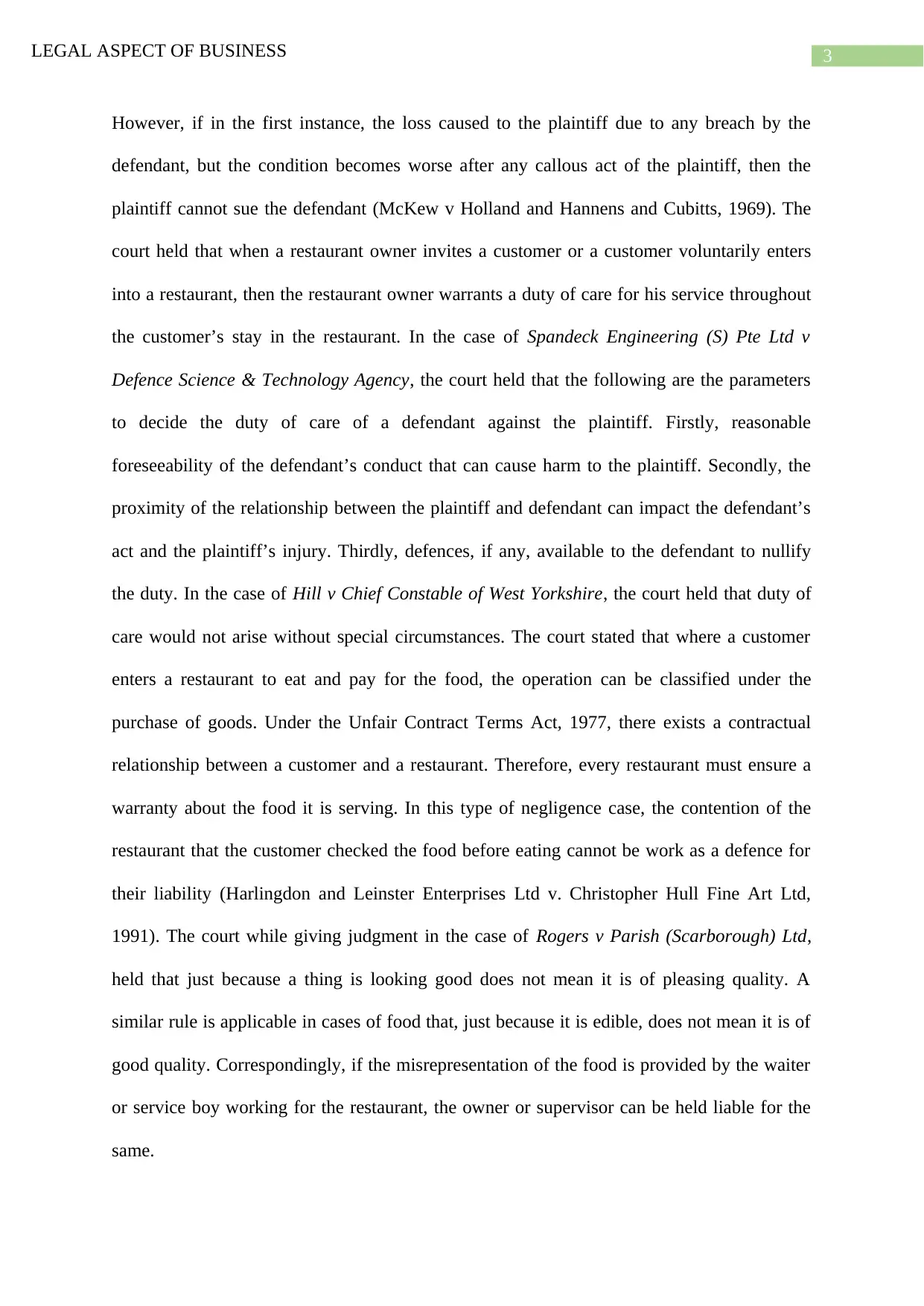
3LEGAL ASPECT OF BUSINESS
However, if in the first instance, the loss caused to the plaintiff due to any breach by the
defendant, but the condition becomes worse after any callous act of the plaintiff, then the
plaintiff cannot sue the defendant (McKew v Holland and Hannens and Cubitts, 1969). The
court held that when a restaurant owner invites a customer or a customer voluntarily enters
into a restaurant, then the restaurant owner warrants a duty of care for his service throughout
the customer’s stay in the restaurant. In the case of Spandeck Engineering (S) Pte Ltd v
Defence Science & Technology Agency, the court held that the following are the parameters
to decide the duty of care of a defendant against the plaintiff. Firstly, reasonable
foreseeability of the defendant’s conduct that can cause harm to the plaintiff. Secondly, the
proximity of the relationship between the plaintiff and defendant can impact the defendant’s
act and the plaintiff’s injury. Thirdly, defences, if any, available to the defendant to nullify
the duty. In the case of Hill v Chief Constable of West Yorkshire, the court held that duty of
care would not arise without special circumstances. The court stated that where a customer
enters a restaurant to eat and pay for the food, the operation can be classified under the
purchase of goods. Under the Unfair Contract Terms Act, 1977, there exists a contractual
relationship between a customer and a restaurant. Therefore, every restaurant must ensure a
warranty about the food it is serving. In this type of negligence case, the contention of the
restaurant that the customer checked the food before eating cannot be work as a defence for
their liability (Harlingdon and Leinster Enterprises Ltd v. Christopher Hull Fine Art Ltd,
1991). The court while giving judgment in the case of Rogers v Parish (Scarborough) Ltd,
held that just because a thing is looking good does not mean it is of pleasing quality. A
similar rule is applicable in cases of food that, just because it is edible, does not mean it is of
good quality. Correspondingly, if the misrepresentation of the food is provided by the waiter
or service boy working for the restaurant, the owner or supervisor can be held liable for the
same.
However, if in the first instance, the loss caused to the plaintiff due to any breach by the
defendant, but the condition becomes worse after any callous act of the plaintiff, then the
plaintiff cannot sue the defendant (McKew v Holland and Hannens and Cubitts, 1969). The
court held that when a restaurant owner invites a customer or a customer voluntarily enters
into a restaurant, then the restaurant owner warrants a duty of care for his service throughout
the customer’s stay in the restaurant. In the case of Spandeck Engineering (S) Pte Ltd v
Defence Science & Technology Agency, the court held that the following are the parameters
to decide the duty of care of a defendant against the plaintiff. Firstly, reasonable
foreseeability of the defendant’s conduct that can cause harm to the plaintiff. Secondly, the
proximity of the relationship between the plaintiff and defendant can impact the defendant’s
act and the plaintiff’s injury. Thirdly, defences, if any, available to the defendant to nullify
the duty. In the case of Hill v Chief Constable of West Yorkshire, the court held that duty of
care would not arise without special circumstances. The court stated that where a customer
enters a restaurant to eat and pay for the food, the operation can be classified under the
purchase of goods. Under the Unfair Contract Terms Act, 1977, there exists a contractual
relationship between a customer and a restaurant. Therefore, every restaurant must ensure a
warranty about the food it is serving. In this type of negligence case, the contention of the
restaurant that the customer checked the food before eating cannot be work as a defence for
their liability (Harlingdon and Leinster Enterprises Ltd v. Christopher Hull Fine Art Ltd,
1991). The court while giving judgment in the case of Rogers v Parish (Scarborough) Ltd,
held that just because a thing is looking good does not mean it is of pleasing quality. A
similar rule is applicable in cases of food that, just because it is edible, does not mean it is of
good quality. Correspondingly, if the misrepresentation of the food is provided by the waiter
or service boy working for the restaurant, the owner or supervisor can be held liable for the
same.
Paraphrase This Document
Need a fresh take? Get an instant paraphrase of this document with our AI Paraphraser
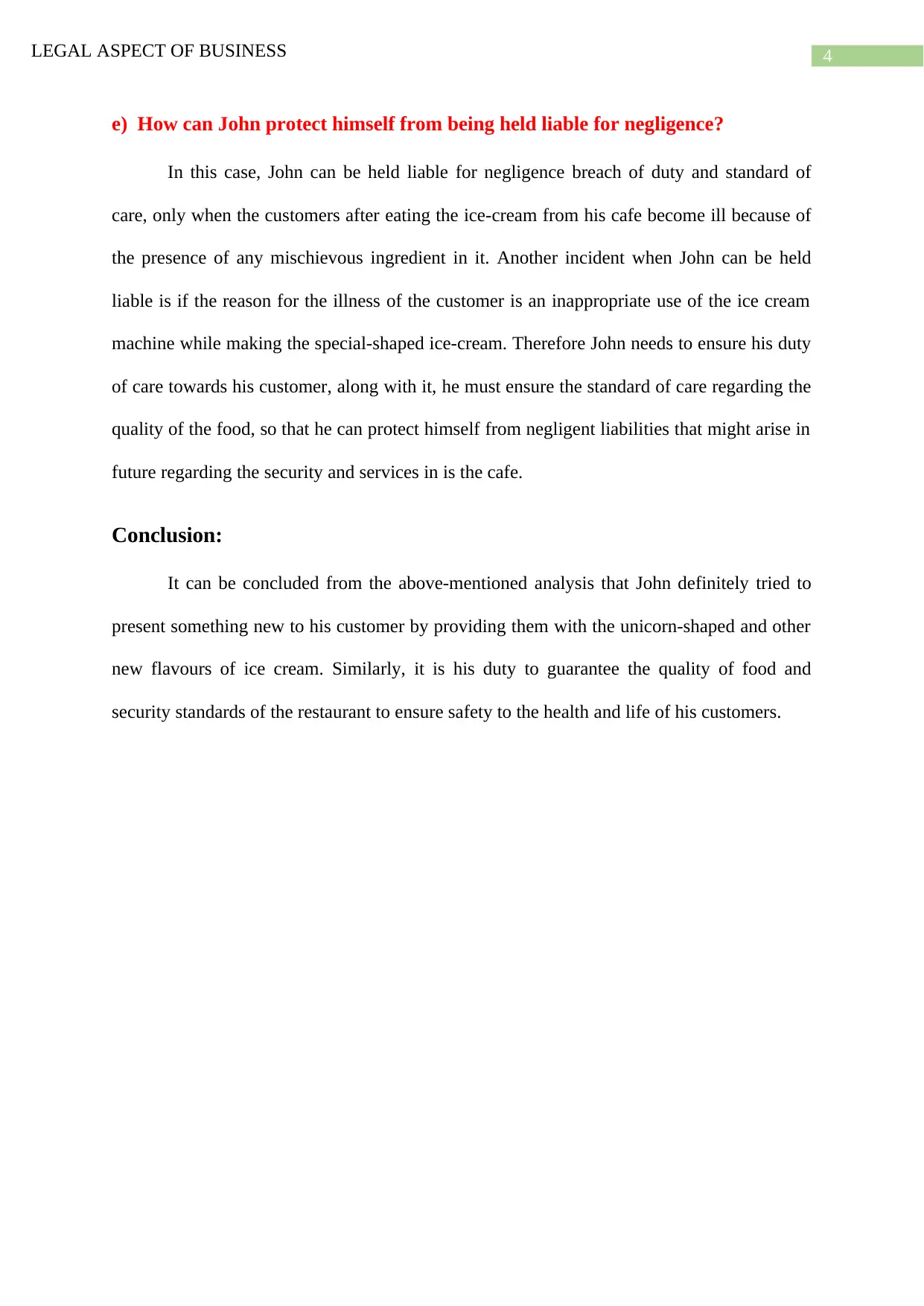
4LEGAL ASPECT OF BUSINESS
e) How can John protect himself from being held liable for negligence?
In this case, John can be held liable for negligence breach of duty and standard of
care, only when the customers after eating the ice-cream from his cafe become ill because of
the presence of any mischievous ingredient in it. Another incident when John can be held
liable is if the reason for the illness of the customer is an inappropriate use of the ice cream
machine while making the special-shaped ice-cream. Therefore John needs to ensure his duty
of care towards his customer, along with it, he must ensure the standard of care regarding the
quality of the food, so that he can protect himself from negligent liabilities that might arise in
future regarding the security and services in is the cafe.
Conclusion:
It can be concluded from the above-mentioned analysis that John definitely tried to
present something new to his customer by providing them with the unicorn-shaped and other
new flavours of ice cream. Similarly, it is his duty to guarantee the quality of food and
security standards of the restaurant to ensure safety to the health and life of his customers.
e) How can John protect himself from being held liable for negligence?
In this case, John can be held liable for negligence breach of duty and standard of
care, only when the customers after eating the ice-cream from his cafe become ill because of
the presence of any mischievous ingredient in it. Another incident when John can be held
liable is if the reason for the illness of the customer is an inappropriate use of the ice cream
machine while making the special-shaped ice-cream. Therefore John needs to ensure his duty
of care towards his customer, along with it, he must ensure the standard of care regarding the
quality of the food, so that he can protect himself from negligent liabilities that might arise in
future regarding the security and services in is the cafe.
Conclusion:
It can be concluded from the above-mentioned analysis that John definitely tried to
present something new to his customer by providing them with the unicorn-shaped and other
new flavours of ice cream. Similarly, it is his duty to guarantee the quality of food and
security standards of the restaurant to ensure safety to the health and life of his customers.
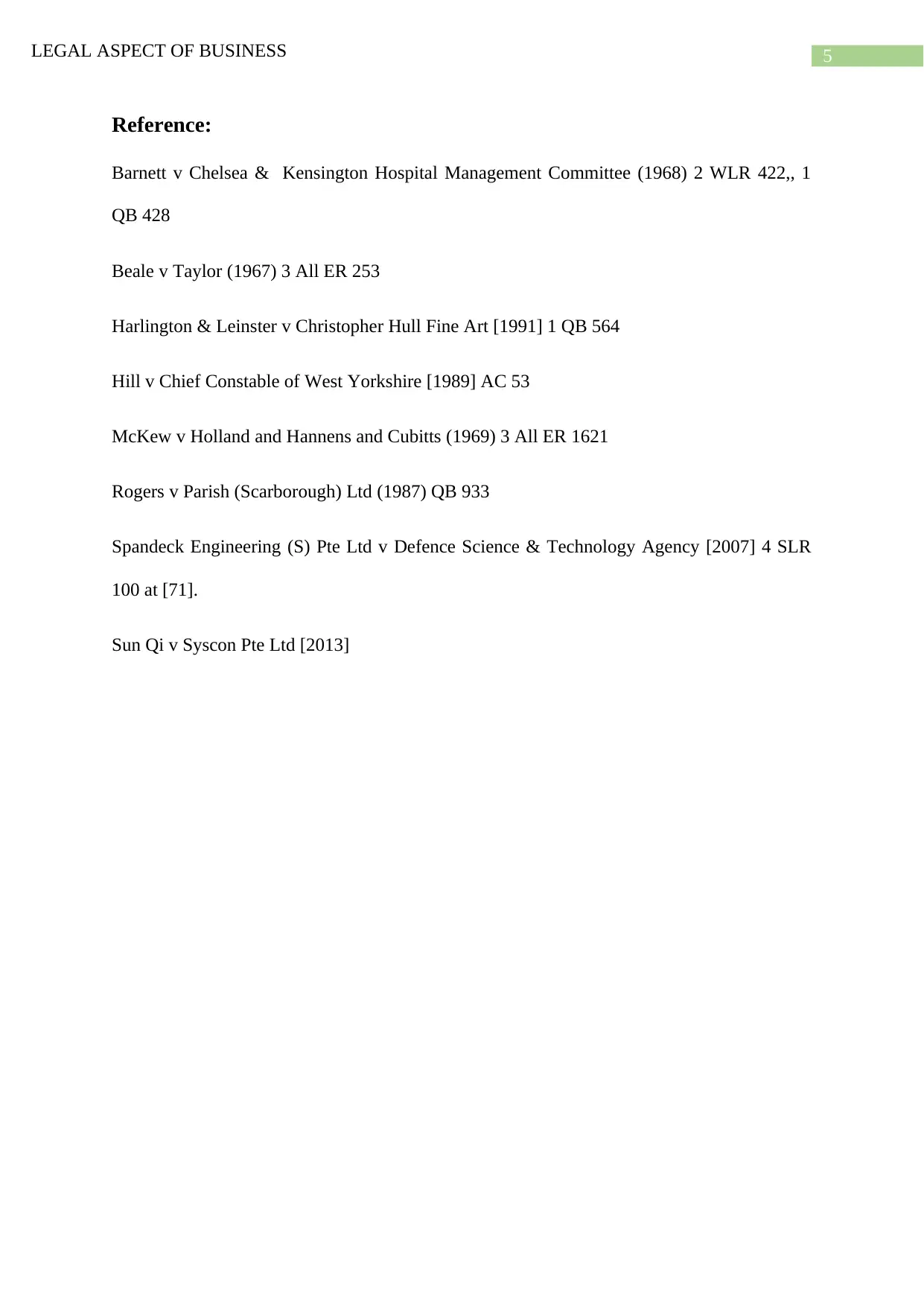
5LEGAL ASPECT OF BUSINESS
Reference:
Barnett v Chelsea & Kensington Hospital Management Committee (1968) 2 WLR 422,, 1
QB 428
Beale v Taylor (1967) 3 All ER 253
Harlington & Leinster v Christopher Hull Fine Art [1991] 1 QB 564
Hill v Chief Constable of West Yorkshire [1989] AC 53
McKew v Holland and Hannens and Cubitts (1969) 3 All ER 1621
Rogers v Parish (Scarborough) Ltd (1987) QB 933
Spandeck Engineering (S) Pte Ltd v Defence Science & Technology Agency [2007] 4 SLR
100 at [71].
Sun Qi v Syscon Pte Ltd [2013]
Reference:
Barnett v Chelsea & Kensington Hospital Management Committee (1968) 2 WLR 422,, 1
QB 428
Beale v Taylor (1967) 3 All ER 253
Harlington & Leinster v Christopher Hull Fine Art [1991] 1 QB 564
Hill v Chief Constable of West Yorkshire [1989] AC 53
McKew v Holland and Hannens and Cubitts (1969) 3 All ER 1621
Rogers v Parish (Scarborough) Ltd (1987) QB 933
Spandeck Engineering (S) Pte Ltd v Defence Science & Technology Agency [2007] 4 SLR
100 at [71].
Sun Qi v Syscon Pte Ltd [2013]
⊘ This is a preview!⊘
Do you want full access?
Subscribe today to unlock all pages.

Trusted by 1+ million students worldwide
1 out of 6
Related Documents
Your All-in-One AI-Powered Toolkit for Academic Success.
+13062052269
info@desklib.com
Available 24*7 on WhatsApp / Email
![[object Object]](/_next/static/media/star-bottom.7253800d.svg)
Unlock your academic potential
Copyright © 2020–2025 A2Z Services. All Rights Reserved. Developed and managed by ZUCOL.





